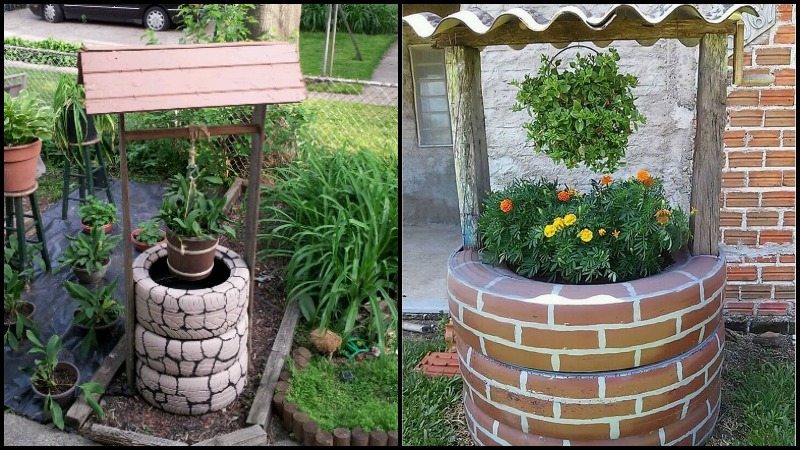
Put some magic in your garden with this great décor idea – a wishing well planter made from recycled tires! It’s the perfect addition to your garden and it’s so easy to make.
A wishing well planter is an excellent way to display your love of nature and the environment. It is made from a recycled tire that will beautify your home landscape and provide an opportunity to enjoy watching a plant grow.
A wishing well planter made from a recycled tire can be created in less than an hour and can last for years. Recycled tire planters can add life to your yard or garden with little effort or cost.
A discarded tire can be easily transformed into a colorful, durable planter for your small plants or hardy outdoor plants. Tire planters are inexpensive. They can add a touch of color to the dullest of yards. They last for years and can be recycled for other projects.
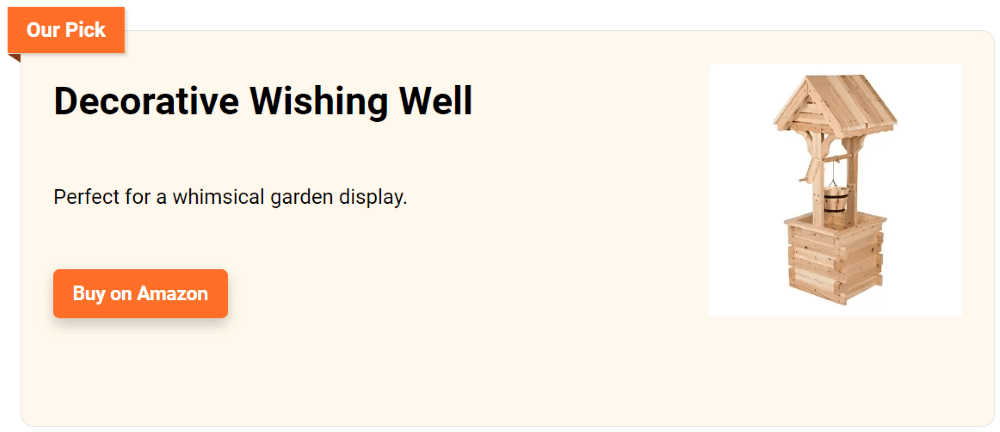
Building a Wishing Well Planter
Materials
- 3 Old Tires
- Roofing Material
- Timber (for the roof supports)
- Landscaping Adhesive
- Exterior Spray Paint (your choice of color)
- White Paint
- Wood Screws
- Soil
- Rustic Water Bucket Hanging Planter
- Screw-in Hook
- Plants
Tools
- Measuring Tape
- Paintbrush
- Cordless Drill
- Saw
- Jigsaw (optional, for cutting square holes on the tires)
- Shovel
Instructions
First, you will have to cut two square holes on each of the three tires. These holes are where you would insert the roof supports, so their dimensions would depend on the size of your timber.
Then Stack the tires on top of each other, securing them with landscaping adhesive. Make sure that the holes you cut are aligned!
Next, paint the tires so that it looks like a real wishing well. Spray paint the tires with any color that you desire and then add white lines to get the illusion of a brick wall.
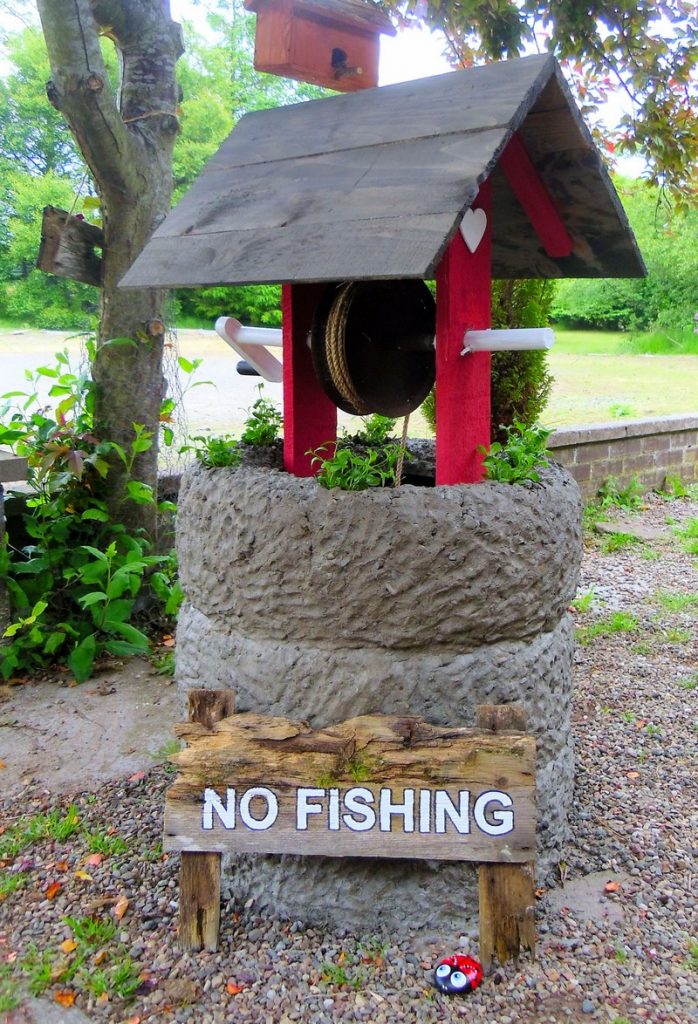
The shape and size of a wishing well planter are important because they will influence the style of your garden. The planter also determines how much space you have to play with when designing your garden.
Now building the roof for your tire wishing well would depend on the materials available and your idea for its design. There are several options for a wishing well roof, but a lot depends on your budget.
You can tack on a wishing well to just about any style of roof, but it is most common to see them on cedar shake roofs. Ultimately, you can use a variety of materials for your wishing well roof.
You may use real roof shingles, timber slats, plywood, PVC pipes, or tire cutouts if you have an extra tire. Paint the roof structure, if you want, before attaching it to the tires.
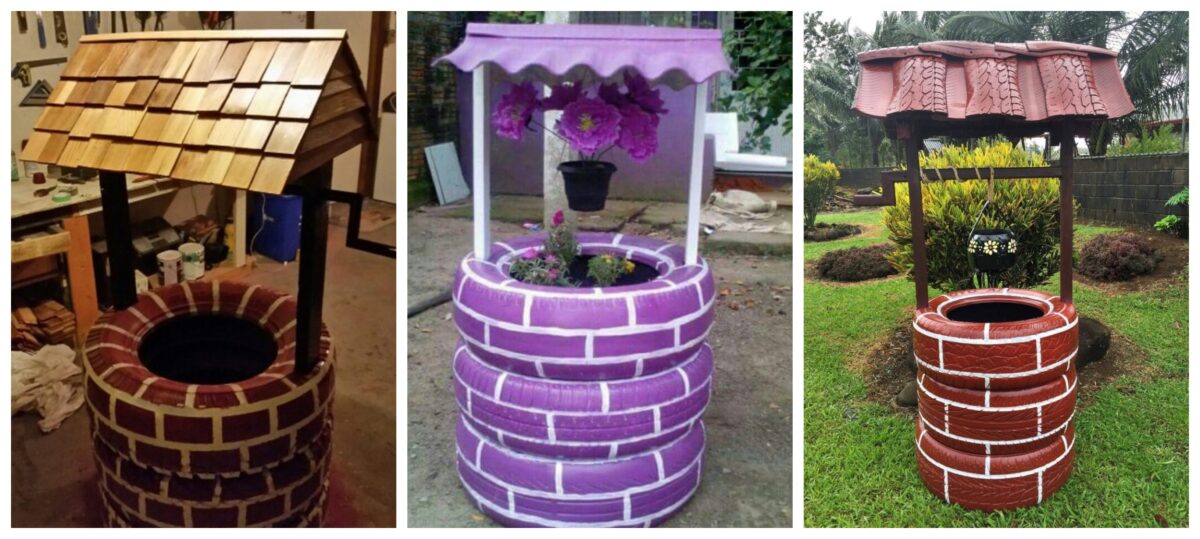
If you need inspiration, you can choose from several ideas shown in our gallery below.
Don’t forget to add a hanging basket planter using a bucket! This will complete your tire wishing well planter and a rustic water bucket is perfect for this! This wishing well planter is convenient to move around as well, so you can put it anywhere in your yard.
Note: You also have the option to do away with the hole-cutting step. You can simply attach your roof supports after painting by screwing them along the outside of the tires. Use adhesive as well for a more secure structure.
Maintenance Tips for Wishing Well Planters
Wishing well planters crafted from recycled tires offer a unique and sustainable addition to any garden. While these planters are durable and eco-friendly, they require proper maintenance to ensure they continue to enhance your outdoor space effectively.
Here are essential tips to keep your wishing well planter in top condition, ensuring it remains a focal point in your garden for years to come.
Regular Cleaning
To maintain the aesthetic appeal of your wishing well planter, regular cleaning is crucial. Dust, dirt, and garden debris can accumulate on the surface, detracting from its appearance. Use a mild soap and water solution to gently clean the tires, paying special attention to crevices where dirt may collect. Rinse thoroughly with a hose. This simple step will keep your planter looking fresh and vibrant.
Checking for Water Drainage
Effective drainage is vital for plant health in any planter, including wishing well planters. Over time, the drainage holes may become clogged with soil or debris, leading to waterlogged conditions that can harm your plants. Periodically check and clear these holes to ensure water can freely exit the planter, preventing root rot and other moisture-related issues.
Paint and Structural Maintenance
If you’ve painted your wishing well planter to enhance its appearance or mimic a traditional wishing well’s look, the paint may fade or chip over time. Schedule an annual touch-up session to keep the planter looking its best. Use outdoor-grade paint suitable for rubber surfaces to ensure longevity and resistance to the elements.
Regularly inspect the structural components of your wishing well planter, such as the roof supports and the overall stability of the stacked tires. Tighten any loose screws and replace damaged parts as needed. Ensuring the planter’s structure is sound not only keeps it safe but also prolongs its life.
Seasonal Care
Adapting your maintenance routine to the changing seasons is crucial for the longevity of your wishing well planter and the health of its plants. During the colder months, it’s essential to protect your planter from the harsh elements. If your wishing well planter is portable, consider moving it to a sheltered area to shield it from extreme cold and frost.
The low temperatures can cause the rubber in the tires to become brittle and crack, compromising the structural integrity of the planter. Adding a layer of mulch or straw can also help insulate the soil, providing extra warmth to the plant roots.
In contrast, the summer season presents a different set of challenges, particularly in hot climates. High temperatures can stress plants and accelerate soil drying. To mitigate these effects, ensure the plants in your wishing well planter are heat-tolerant varieties that can withstand the summer sun.
Positioning the planter in a location where it can receive partial shade during the hottest parts of the day can also help prevent overheating. Additionally, increasing watering frequency and checking the soil moisture regularly will ensure your plants remain hydrated and healthy throughout the summer.
Plant Health Monitoring
The vitality of your wishing well planter is intrinsically linked to the health of the plants it houses. Regular observation and care are paramount to identifying and addressing any signs of plant distress early. Symptoms such as wilting, yellowing leaves, stunted growth, or the presence of pests and diseases can indicate underlying issues with the planter’s environment or care regimen.
Wilting and yellowing leaves can often be a sign of water stress, either too much or too little, or a nutrient imbalance in the soil. Adjust watering practices accordingly and consider supplementing with a balanced, slow-release fertilizer to address nutrient deficiencies. Stunted growth may indicate overcrowding, root-bound conditions, or the need for repotting into a larger wishing well planter.
Pest infestations and diseases can spread rapidly if not treated promptly. Regular checks will allow you to catch these problems early and take action. Use environmentally friendly pest control methods, such as neem oil or insecticidal soap, to manage infestations without harming the surrounding environment. Removing and destroying infected plant parts can help prevent the spread of diseases.
Maintaining your wishing well planter involves a combination of regular cleaning, structural checks, and seasonal adjustments. By following these tips, you can ensure that your recycled tire planter remains a beautiful and sustainable feature in your garden, showcasing your commitment to eco-friendly gardening practices while providing a nurturing environment for your plants.
Click on any image to start the lightbox display. Use your Esc key to close the lightbox. You can also view the images as a slideshow if you prefer ![]()
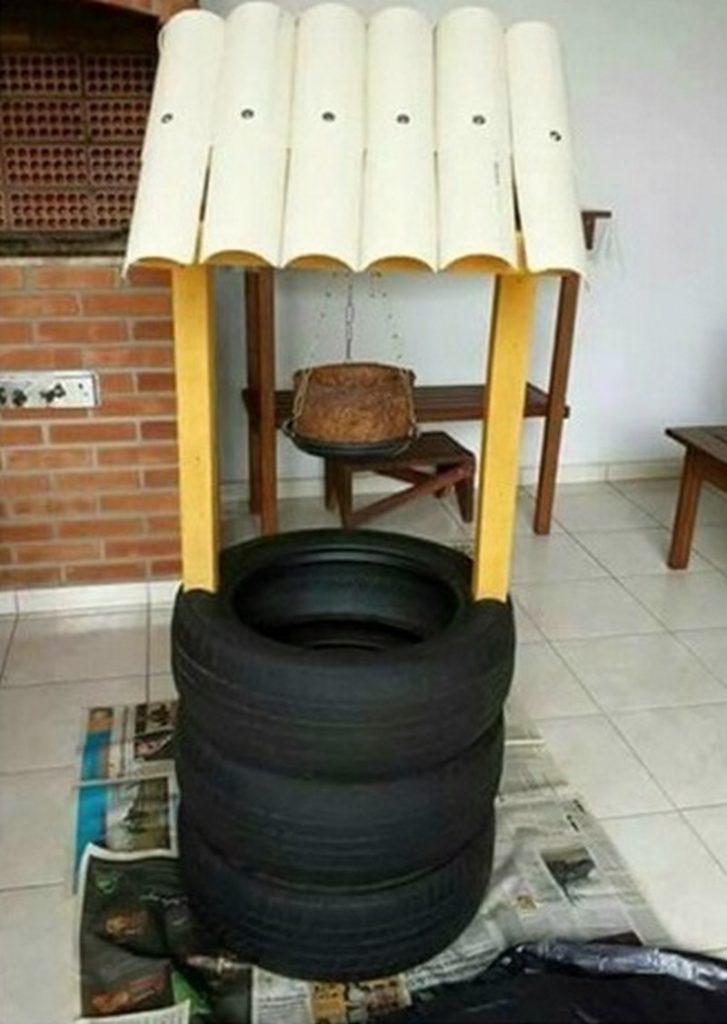

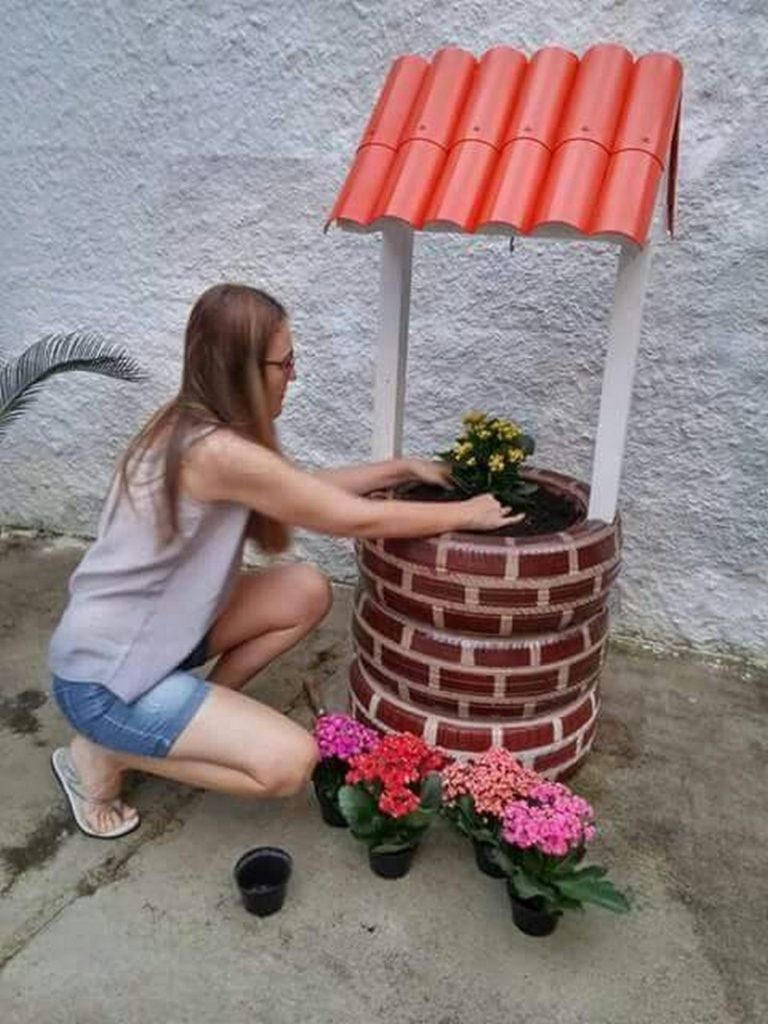
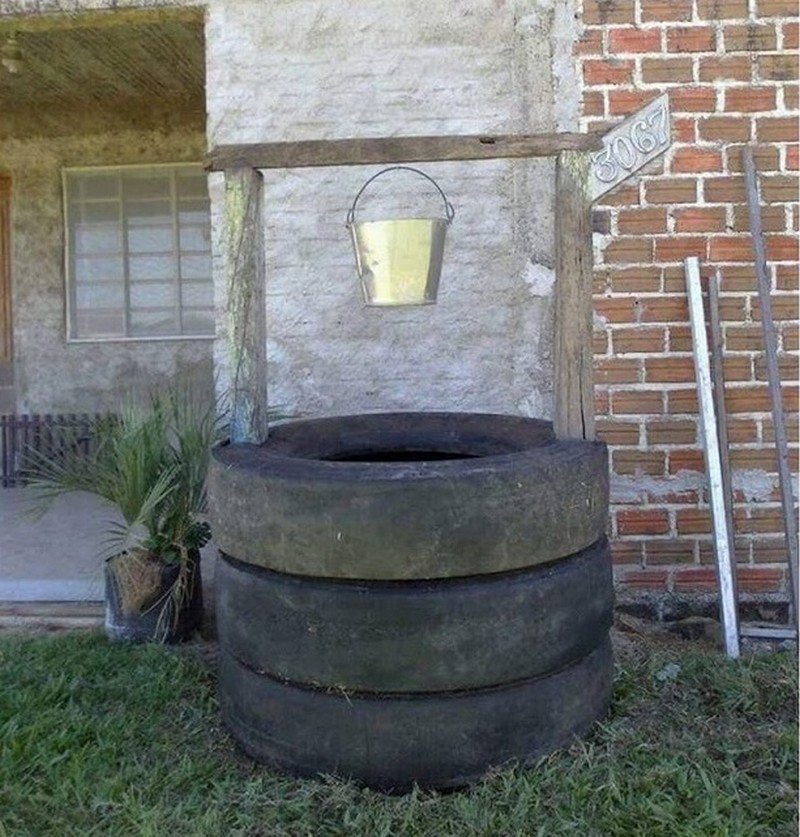
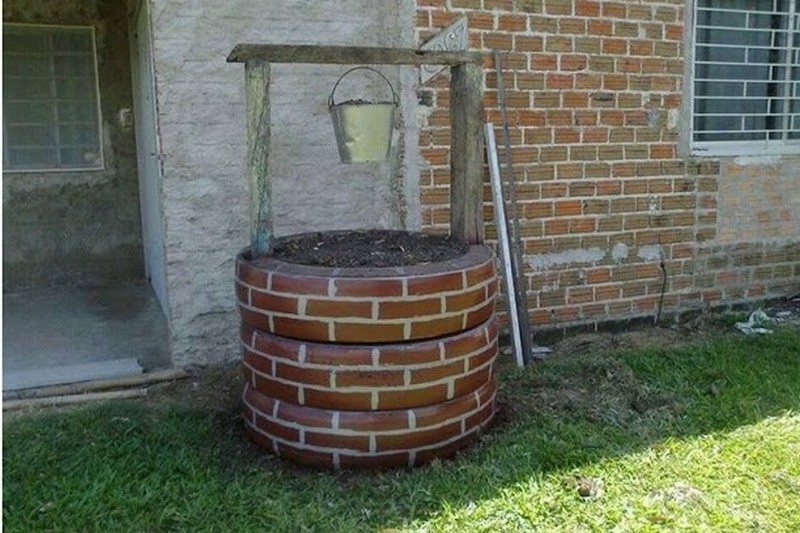
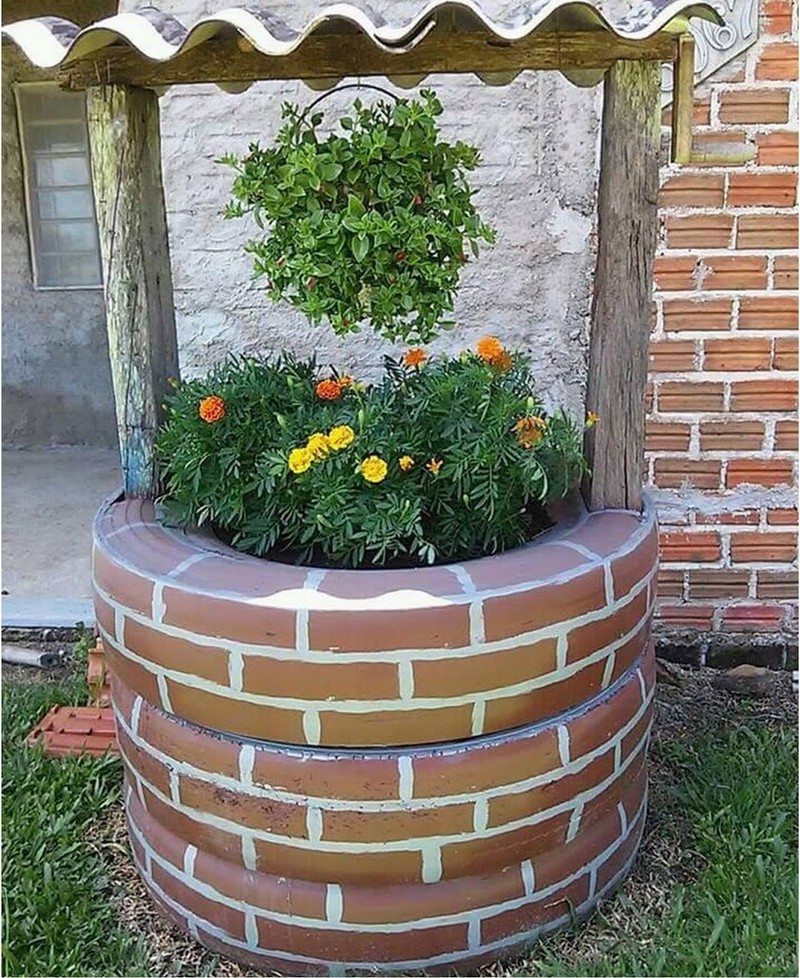
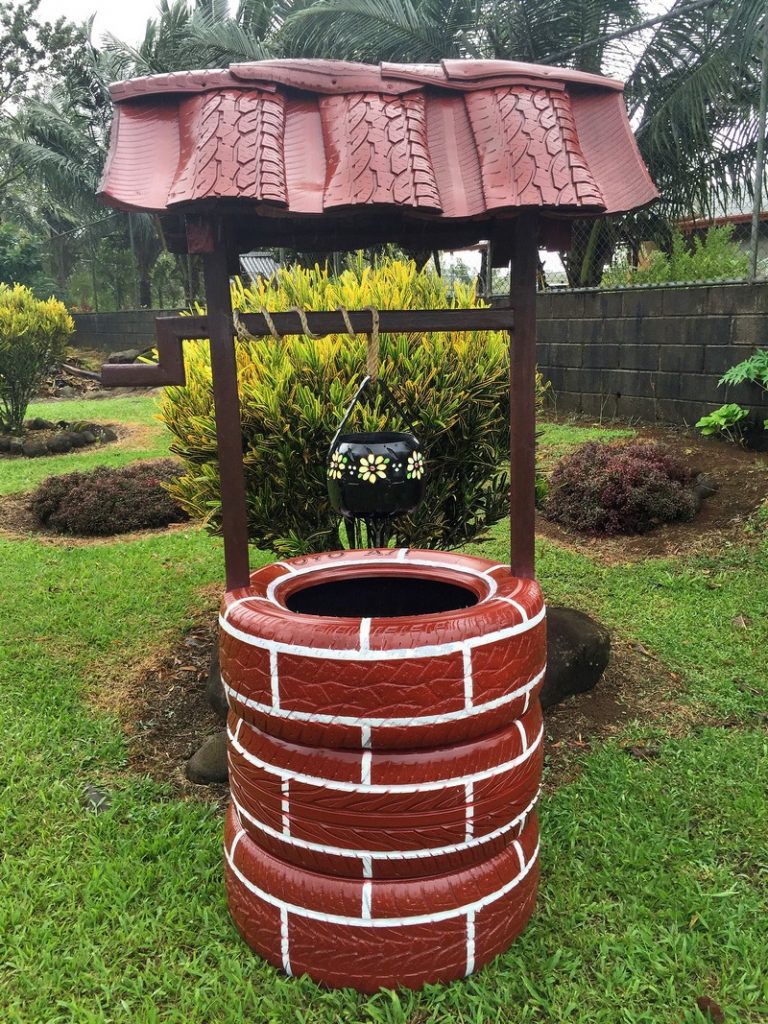
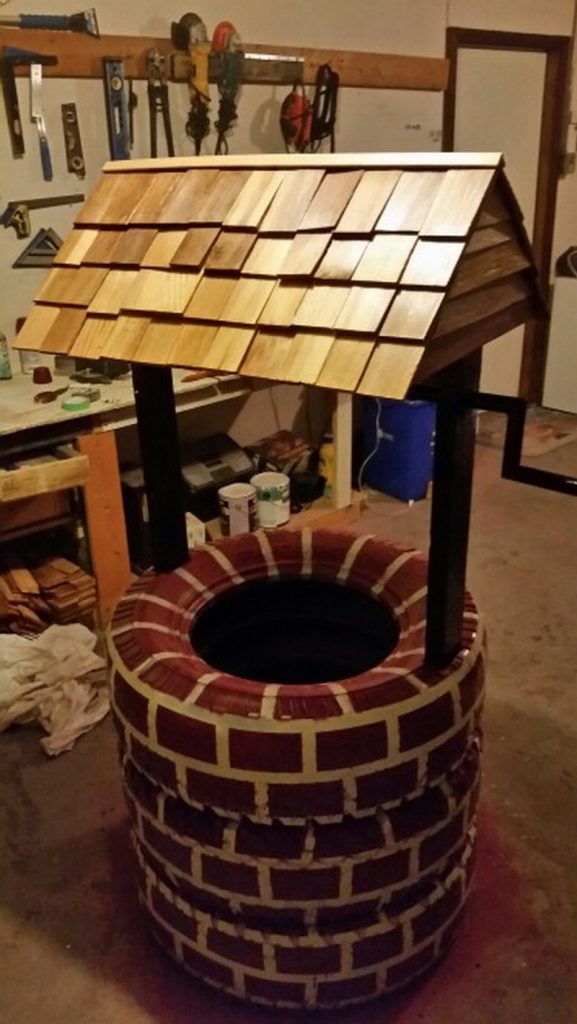
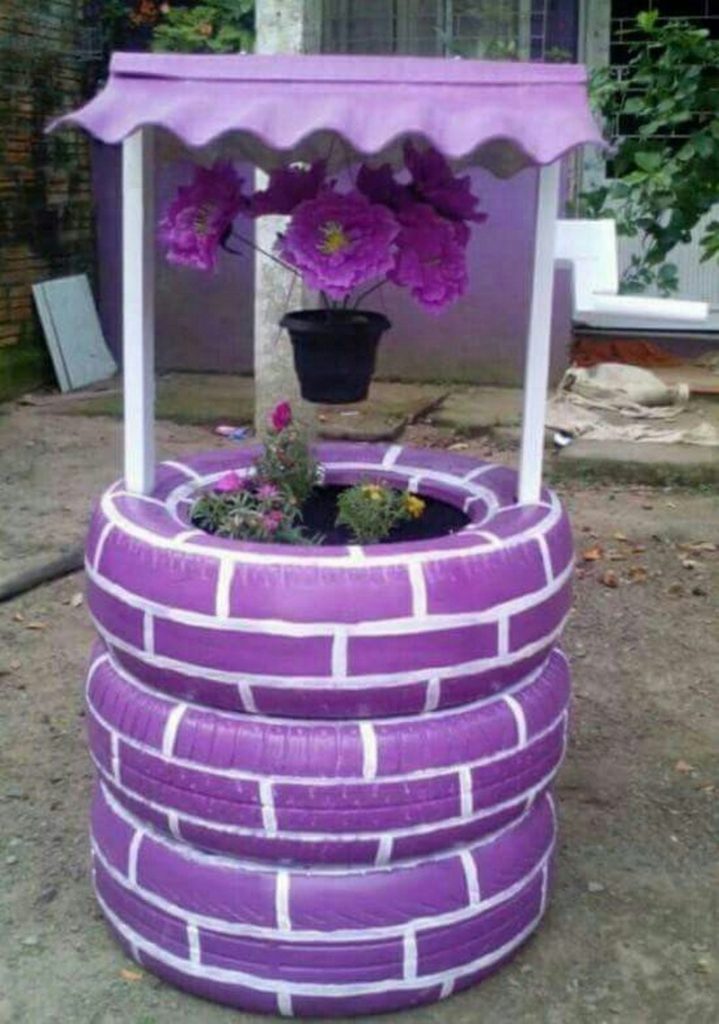
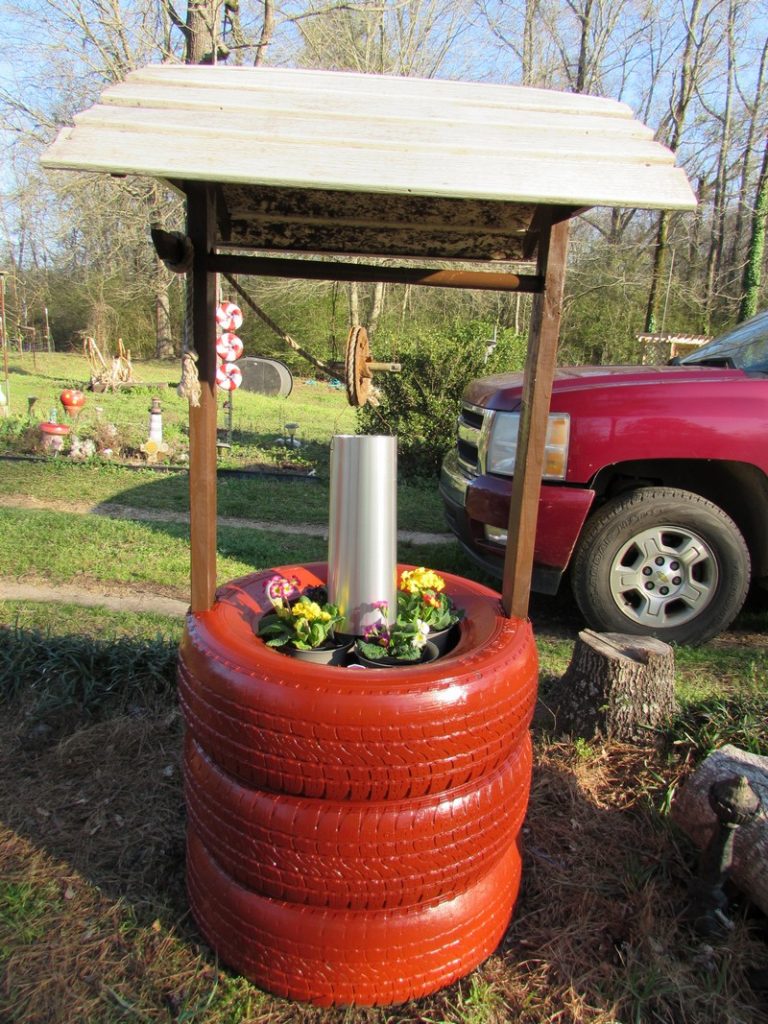
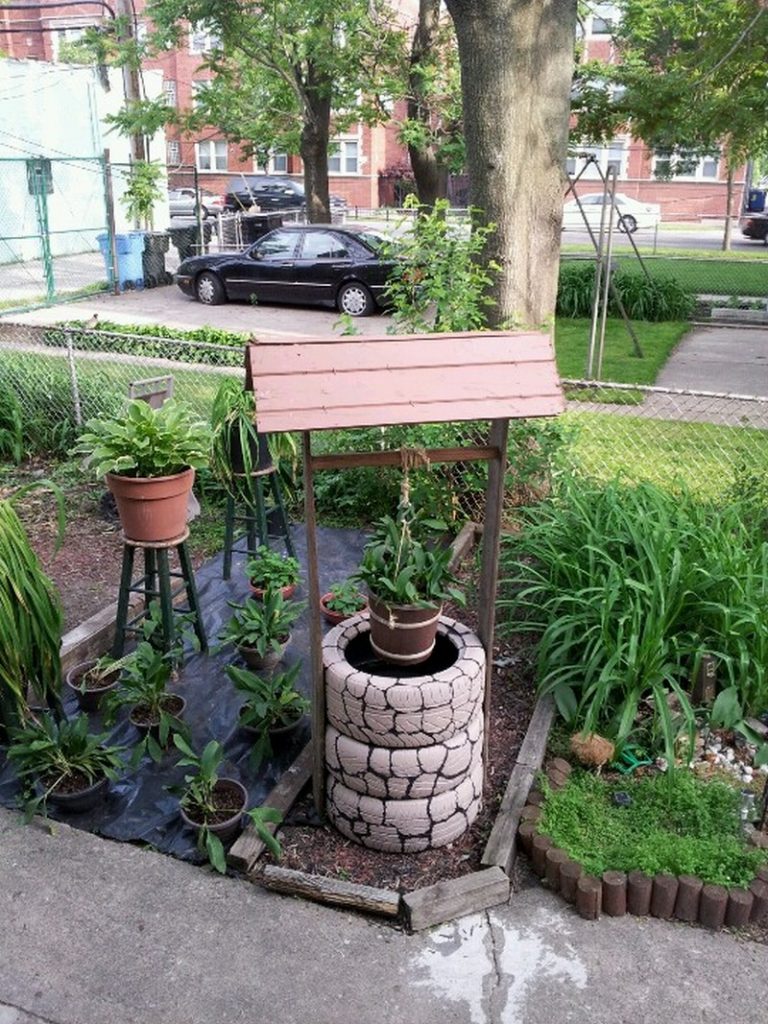

You can get the step-by-step instructions here…
Environmental Benefits of Using Recycled Tires in Gardening
Innovative gardening practices, such as creating a wishing well planter from recycled tires, offer not just aesthetic appeal but also significant environmental advantages. This sustainable approach to gardening not only transforms a garden’s appearance but also contributes positively to environmental conservation.
Below, we delve into the benefits of utilizing recycled tires in gardening, with a focus on the enchanting wishing well planter.
Reducing Waste in Landfills
The initiative to repurpose recycled tires into projects like the wishing well planter presents a strategic solution to one of the environmental challenges: the accumulation of waste in landfills. Tires, composed of durable materials designed to withstand extensive wear, are particularly resistant to the natural decomposition processes. This durability, while beneficial for their intended use, results in tires occupying landfill space for centuries, potentially leaching harmful chemicals into the surrounding soil and waterways.
By transforming these tires into garden planters, we not only prevent this environmental hazard but also contribute to the beautification of our surroundings. This innovative recycling effort significantly reduces the ecological footprint of discarded tires, showcasing a practical approach to waste management that can be replicated with various materials.
Conserving Natural Resources
The fabrication of a wishing well planter from recycled tires represents a significant step toward natural resource conservation. Traditional manufacturing processes for garden containers and related materials are resource-intensive, requiring significant amounts of raw materials, water, and energy. This not only depletes the earth’s finite resources but also exacerbates the environmental impact associated with extraction and processing activities.
In contrast, the creation of recycled tire planters circumvents the need for new materials, offering an inventive and sustainable alternative. This conservation effort is particularly crucial in today’s context, where the pressure on natural resources is ever-increasing. By choosing to repurpose existing materials, we not only alleviate the demand on these resources but also minimize the energy expenditure and environmental degradation associated with their procurement and processing.
Lowering Carbon Footprint
Utilizing recycled tires for gardening purposes, notably in the construction of wishing well planters, plays a pivotal role in reducing the carbon footprint associated with gardening activities. The process of recycling tires is inherently less energy-intensive compared to the production of new gardening containers from virgin materials.
The efficiency in recycling translates to a reduction in greenhouse gas emissions, as the energy savings from using recycled materials directly correlate with fewer carbon emissions released into the atmosphere. Moreover, this practice aligns with broader environmental goals, supporting efforts to combat climate change through sustainable waste management and recycling initiatives. By advocating for and adopting such eco-friendly practices, individuals and communities can contribute to a significant reduction in global carbon emissions, paving the way for a more sustainable and resilient future.
Promoting Eco-Friendly Gardening Practices
The integration of wishing well planters crafted from recycled tires into garden spaces serves as a beacon of eco-friendly practices, highlighting the beauty and practicality of sustainable gardening. These planters are not just decorative elements but powerful symbols of environmental stewardship.
They encourage gardeners to embrace sustainability in every aspect of their gardening endeavors, from the selection of plants to the methods of care and cultivation. The adoption of wishing well planters made from recycled materials can inspire a shift towards more sustainable practices, such as composting kitchen scraps to enrich garden soil naturally or opting for organic fertilizers over chemical alternatives.
This push towards eco-conscious gardening practices not only benefits the immediate environment by reducing chemical runoff and soil degradation but also fosters a deeper connection between gardeners and the natural world, promoting a harmonious balance that is essential for the health of our planet.
Enhancing Soil and Plant Health
Wishing well planters, ingeniously crafted from recycled tires, offer more than just an aesthetically pleasing addition to gardens. They play a pivotal role in enhancing the health of soil and plants. The unique properties of rubber tires, including excellent drainage and aeration capabilities, ensure that plants receive the optimal balance of water and air necessary for healthy root development.
Furthermore, the insulating nature of rubber provides a stable temperature environment for plant roots, safeguarding them against the harsh extremes of cold winters and hot summers. This protection is crucial for the growth and resilience of plants, allowing them to thrive in conditions that might otherwise stress or harm them.
Encouraging Creativity and Innovation
The creation of wishing well planters from recycled tires stands at the intersection of sustainability and creativity, sparking innovation in the realm of gardening. This inventive reuse of materials challenges traditional notions of what gardening elements can be, inviting gardeners and enthusiasts to explore new possibilities in garden design and functionality.
The process of transforming an ordinary, discarded tire into a charming wishing well planter is an act of creative reinvention that demonstrates the potential for beauty and utility in unexpected places. This approach not only enriches the aesthetic diversity of garden spaces but also encourages a culture of innovation that values resourcefulness and environmental responsibility. As gardeners experiment with recycled materials and incorporate sustainable designs into their landscapes, they contribute to a growing movement that celebrates the fusion of artistry, gardening, and environmental conservation.
Best Plants for Wishing Well Planters
Tire planters, especially those fashioned into wishing well designs, offer a unique and sustainable way to enhance garden spaces. These recycled creations not only contribute positively to the environment by repurposing old tires but also provide a distinctive aesthetic appeal.
Here, we explore some of the best plants suited for growth in tire planters, ensuring your wishing well becomes a focal point of beauty and sustainability in your garden.
Succulents and Cacti
Succulents and cacti are ideal for tire planters, including wishing well designs, due to their minimal water requirements and adaptability to confined spaces. These plants thrive in well-drained soil, a condition naturally facilitated by the rubber composition of tires, which prevents water-logging. A wishing well planter adorned with a variety of succulents or cacti can become a low-maintenance, drought-tolerant centerpiece in your garden.
Annual Flowers
Annual flowers, known for their vibrant colors and ability to bloom all season long, are perfect for adding a splash of color to your wishing well tire planters. Petunias, marigolds, and pansies are excellent choices that can handle the unique growing conditions of tire planters. These flowers will cascade beautifully over the edges of the tires, creating a visually striking display that enhances the quaint charm of the wishing well structure.
Perennials
Perennials such as daylilies, lavender, and sedum offer a long-term planting solution for your wishing well tire planters. These hardy plants adapt well to the conditions within tire planters, providing consistent growth and bloom year after year. Their resilience and perennial nature make them an ideal choice for gardeners looking to create a sustainable and enduring garden feature.
Edible Plants
For those interested in combining the decorative with the practical, edible plants like herbs, strawberries, and even some leafy greens can thrive in tire planters. A wishing well planter filled with aromatic herbs such as basil, thyme, and mint not only looks appealing but also provides easy access to fresh culinary ingredients. Strawberries, in particular, are well-suited for tire planters, as their sprawling habit allows them to cascade over the sides, making for an attractive and tasty display.
Climbing Plants
Climbing plants, such as sweet peas, morning glories, and ivy, can add an extra layer of visual interest to a wishing well planter. By installing a simple trellis or support structure within the tire planter, you can encourage these climbers to weave their way up and around the wishing well, creating a lush, green facade that enhances the beauty and natural feel of the planter.
Choosing the right plants for your wishing well planter, particularly when designed as a wishing well, can transform your garden into a sustainable, vibrant, and enchanting space. From the drought-tolerant resilience of succulents to the bountiful beauty of annual flowers, the possibilities are endless.
Conclusion
Creating a wishing well planter from recycled tires blends environmental sustainability with innovative garden design, offering a unique way to beautify any outdoor space. These planters not only reduce waste in landfills but also promote eco-friendly gardening practices by encouraging the reuse of materials. With their ability to enhance soil and plant health while fostering creativity and innovation, wishing well planters stand as a testament to the positive impact of sustainable gardening.
If you liked this, you might also like these gardening ideas and DIY garden art ideas.








